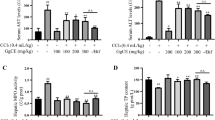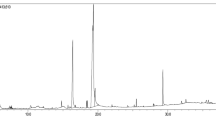Abstract
Dehydroglyasperin C (DGC) isolated from licorice has been shown to exhibit antioxidant activity as well as induce phase 2 detoxifying enzymes in mouse hepatoma cells. This study investigated whether or not DGC exerts hepatoprotective effects through modulation of phase 1 and 2 detoxifying enzymes. ICR mice were divided into five groups with 10 mice per group: (1) negative control, (2) positive control injected with carbon tetrachloride (CCl4, 0.6 mL/kg BW) alone, (3) ICR mice injected with DGC (5 mg/kg BW) alone, (4) ICR mice injected with DGC followed by CCl4, and (5) ICR mice injected with DGC and CCl4 simultaneously. Mice were adapted for 1 week, followed by injection with DGC on day 7, CCl4 on day 8, and sacrifice on day 9 of the experiment. Treatment with DGC induced NQO1 activity in kidney only, but not in the other tissues of mice. Compared to mice injected with CCl4 alone, mice simultaneously injected with both DGC and CCl4 showed reduced lipid droplet formation in liver tissue, as assessed by histological examination. Further, DGC demonstrated a slight protective effect against centrilobular injury caused by CCl4 injection, perhaps through suppression of CYP2E1 expression. In conclusion, DGC possesses hepatoprotective effects against CCl4-induced injury.
Similar content being viewed by others
References
Kim HJ, Seo JY, Suh HJ, Lim SS, Kim JS. Antioxidant activities of licorice-derived prenylflavonoids. Nutr. Res. Pract. 6: 491–498 (2012)
Cuendet M, Guo J, Luo Y, Chen S, Oteham CP, Moon RC, van Breemen RB, Marler LE, Pezzuto JM. Cancer chemopreventive activity and metabolism of isoliquiritigenin, a compound found in licorice. Cancer Prev. Res. (Phila) 3: 221–232 (2012)
Jo EH, Kim SH, Ra JC, Kim SR, Cho SD, Jung JW, Yang SR, Park JS, Hwang JW, Aruoma OI, Kim TY, Lee YS, Kang KS. Chemopreventive properties of the ethanol extract of chinese licorice (Glycyrrhiza uralensis) root: Induction of apoptosis and G1 cell cycle arrest in MCF-7 human breast cancer cells. Cancer Lett. 230: 239–247 (2005)
Lee JY, Lee JH, Park JH, Kim SY, Choi JY, Lee SH, Kim YS, Kang SS, Jang EC, Han Y. Liquiritigenin, a licorice flavonoid, helps mice resist disseminated candidiasis due to Candida albicans by Th1 immune response, whereas liquiritin, its glycoside form, does not. Int. Immunopharmacol. 9: 632–638 (2009)
Kim HJ, Lim SS, Park IS, Lim JS, Seo JY, Kim JS. Neuroprotective effects of dehydroglyasperin C through activation of heme oxygenase-1 in mouse hippocampal cells. J. Agr. Food Chem. 60: 5583–5589 (2012)
Recknagel RO, Glende Jr EA, Dolak JA, Waller RL. Mechanisms of carbon tetrachloride toxicity. Pharmacol. Ther. 43: 139–154 (1989)
McCay PB, Lai EK, Poyer JL, DuBose CM, Janzen EG. Oxygenand carbon-centered free radical formation during carbon tetrachloride metabolism. Observation of lipid radicals in vivo and in vitro. J. Biol. Chem. 259: 2135–2143 (1984)
Weisel T, Baum M, Eisenbrand G, Dietrich H, Will F, Stockis JP, Kulling S, Rufer C, Johannes C, Janzowski C. An anthocyanin/polyphenolic-rich fruit juice reduces oxidative DNA damage and increases glutathione level in healthy probands. Biotechnol. J. 1: 388–397 (2006)
Lopez-Lazaro M. Dual role of hydrogen peroxide in cancer: Possible relevance to cancer chemoprevention and therapy. Cancer Lett. 252: 1–8 (2007)
Finkel T, Holbrook NJ. Oxidants, oxidative stress and the biology of ageing. Nature 408: 239–247 (2000).
Waris G, Ahsan H. Reactive oxygen species: Role in the development of cancer and various chronic conditions. J. Carcinog. 5: 14 (2006)
Cooke MS, Evans MD, Dizdaroglu M, Lunec J. Oxidative DNA damage: Mechanisms, mutation, and disease. FASEB J. 17: 1195–1214 (2003)
Kobayashi M, Yamamoto M. Nrf2-Keap1 regulation of cellular defense mechanisms against electrophiles and reactive oxygen species. Adv. Enzyme Regul. 46: 113–140 (2006)
Surh YJ, Kundu JK, Na HK. Nrf2 as a master redox switch in turning on the cellular signaling involved in the induction of cytoprotective genes by some chemopreventive phytochemicals. Planta Med. 74: 1526–1539 (2008)
Lee YS, Kim SH, Kim JK, Shin HK, Kang YH, Park JH, Lim SS. Rapid identification and preparative isolation of antioxidant components in licorice. J. Sep. Sci. 33: 664–671 (2012).
Benson AM, Hunkeler MJ, Talalay P. Increase of NAD(P)H:quinone reductase by dietary antioxidants: Possible role in protection against carcinogenesis and toxicity. P. Natl. Acad. Sci. USA 77: 5216–5220 (1980)
Lowry OH, Rosebrough NJ, Farr AL, Randall RJ. Protein measurement with the Folin phenol reagent. J. Biol. Chem. 193: 265–275 (1951)
Benzie IFF, Strain JJ. The ferric reducing ability of plasma (FRAP) as a measure of “antioxidant power”: The FRAP assay. Anal. Biochem. 239: 70–76 (1996)
Knecht KT, Mason RP. In vivo radical trapping and biliary secretion of radical adducts of carbon tetrachloride-derived free radical metabolites. Drug Metab. Dispos. 16: 813–817 (1988)
Jiang W, Gao M, Sun S, Bi A, Xin Y, Han X, Wang L, Yin Z, Luo L. Protective effect of L-theanine on carbon tetrachloride-induced acute liver injury in mice. Biochem. Biophys. Res. Commun. 422: 344–350 (2012)
Risal P, Hwang PH, Yun BS, Yi HK, Cho BH, Jang KY, Jeong YJ. Hispidin analogue davallialactone attenuates carbon tetrachlorideinduced hepatotoxicity in mice. J. Nat. Prod. 75: 1683–1689 (2012)
Huang Q, Zhang S, Zheng L, He M, Huang R, Lin X. Hepatoprotective effects of total saponins isolated from Taraphochlamys affinis against carbon tetrachloride induced liver injury in rats. Food Chem. Toxicol. 50: 713–718 (2012)
Zhang S, Lu B, Han X, Xu L, Qi Y, Yin L, Xu Y, Zhao Y, Liu K, Peng J. Protection of the flavonoid fraction from Rosa laevigata Michx. fruit against carbon tetrachloride-induced acute liver injury in mice. Food Chem. Toxicol. 55: 60–69 (2012)
Author information
Authors and Affiliations
Corresponding author
Rights and permissions
About this article
Cite this article
Seo, J.Y., Han, J.H., Kim, Y.J. et al. Protective effects of dehydroglyasperin c against carbon tetrachloride-induced liver damage in mice. Food Sci Biotechnol 23, 547–553 (2014). https://doi.org/10.1007/s10068-014-0075-7
Received:
Revised:
Accepted:
Published:
Issue Date:
DOI: https://doi.org/10.1007/s10068-014-0075-7




